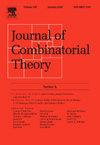On the number of subsequence sums related to the support of a sequence in finite abelian groups
IF 1.2
2区 数学
Q2 MATHEMATICS
引用次数: 0
Abstract
Let G be a finite abelian group and S a sequence with elements of G. Let denote the length of S and the set of all the distinct terms in S. For an integer k with , let denote the set of group elements which can be expressed as a sum of a subsequence of S with length k. Let and . It is known that if , then . In this paper, we determine the structure of a sequence S satisfying and . As a consequence, we can give a counterexample of a conjecture of Gao, Grynkiewicz, and Xia. Moreover, we prove that if and , then . Then we can give an alternative proof of a conjecture of Hamidoune, which was first proved by Gao, Grynkiewicz, and Xia.
有限阿贝尔群中与序列支持度相关的子序列和的数目
设G是一个有限阿贝尔群,S是一个具有G元素的序列,设|S|表示S的长度,supp(S)表示S中所有不同项的集合。对于k∈[1,|S|]的整数k,设Σk(S)∧G表示可以表示为长度为k的S的子序列的和的群元素集合,设Σ(S)=∪k=1|S|Σk(S)和Σ≥k(S)=∪t=k|S|Σt(S)。众所周知,如果0∉Σ(S),然后|Σ(S) |≥| | + |增刊(S) |−1。本文确定了满足0∈Σ(S)和|Σ(S)|=|S|+|supp(S)|−1的序列S的结构。因此,我们可以给出Gao、Grynkiewicz和Xia猜想的一个反例。此外,我们证明如果| |在k和0∉Σ≥k (S)∪增刊(S),然后|Σ≥k (S) |≥|年代|−k + |增刊(S) |。然后,我们可以给出由Gao、Grynkiewicz和Xia首先证明的Hamidoune猜想的另一种证明。
本文章由计算机程序翻译,如有差异,请以英文原文为准。
求助全文
约1分钟内获得全文
求助全文
来源期刊
CiteScore
2.90
自引率
9.10%
发文量
94
审稿时长
12 months
期刊介绍:
The Journal of Combinatorial Theory publishes original mathematical research concerned with theoretical and physical aspects of the study of finite and discrete structures in all branches of science. Series A is concerned primarily with structures, designs, and applications of combinatorics and is a valuable tool for mathematicians and computer scientists.

 求助内容:
求助内容: 应助结果提醒方式:
应助结果提醒方式:


